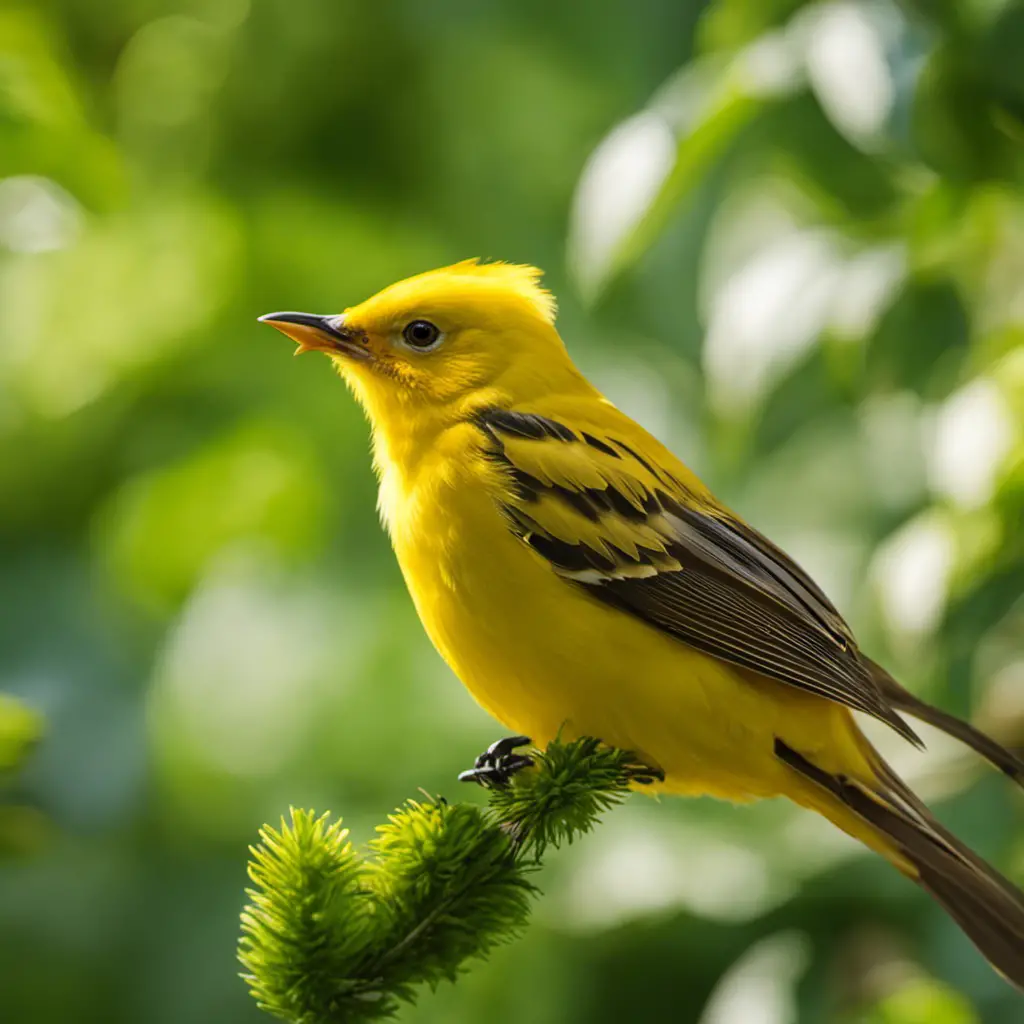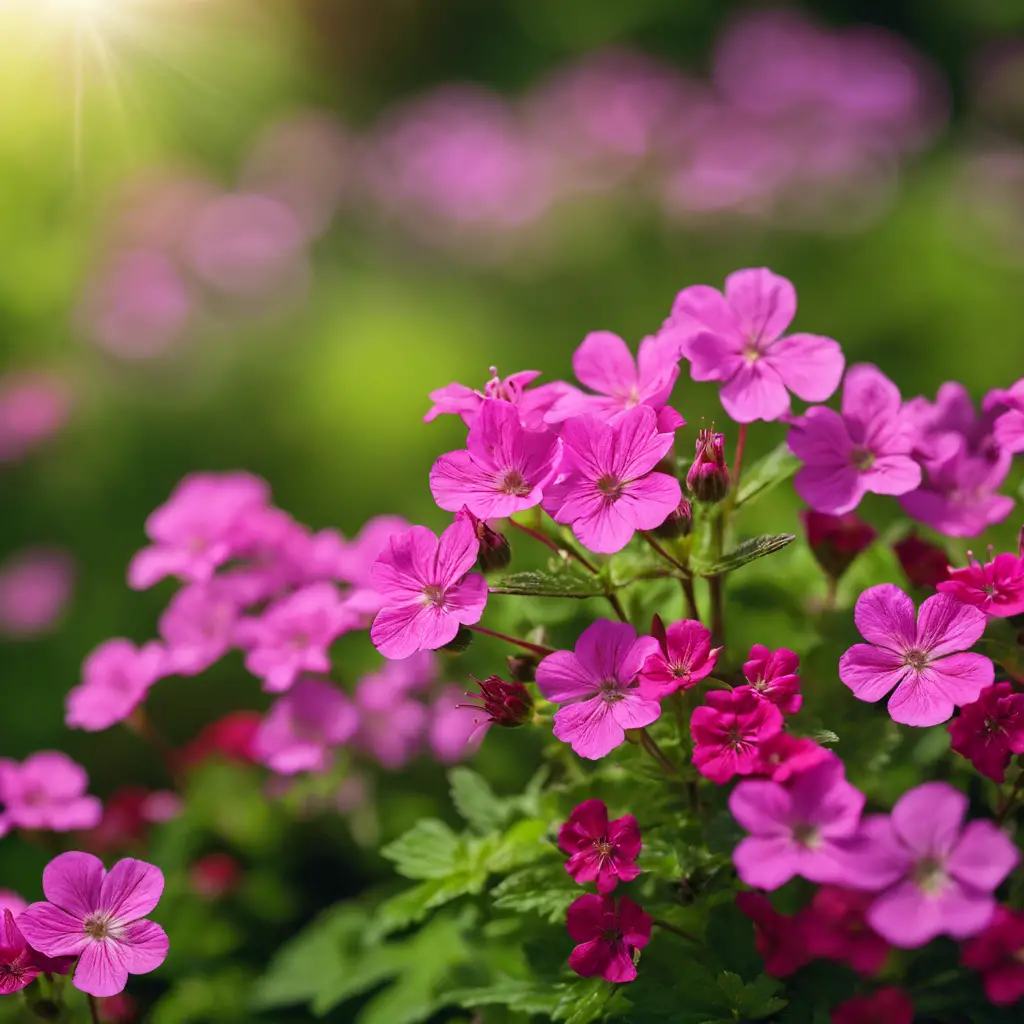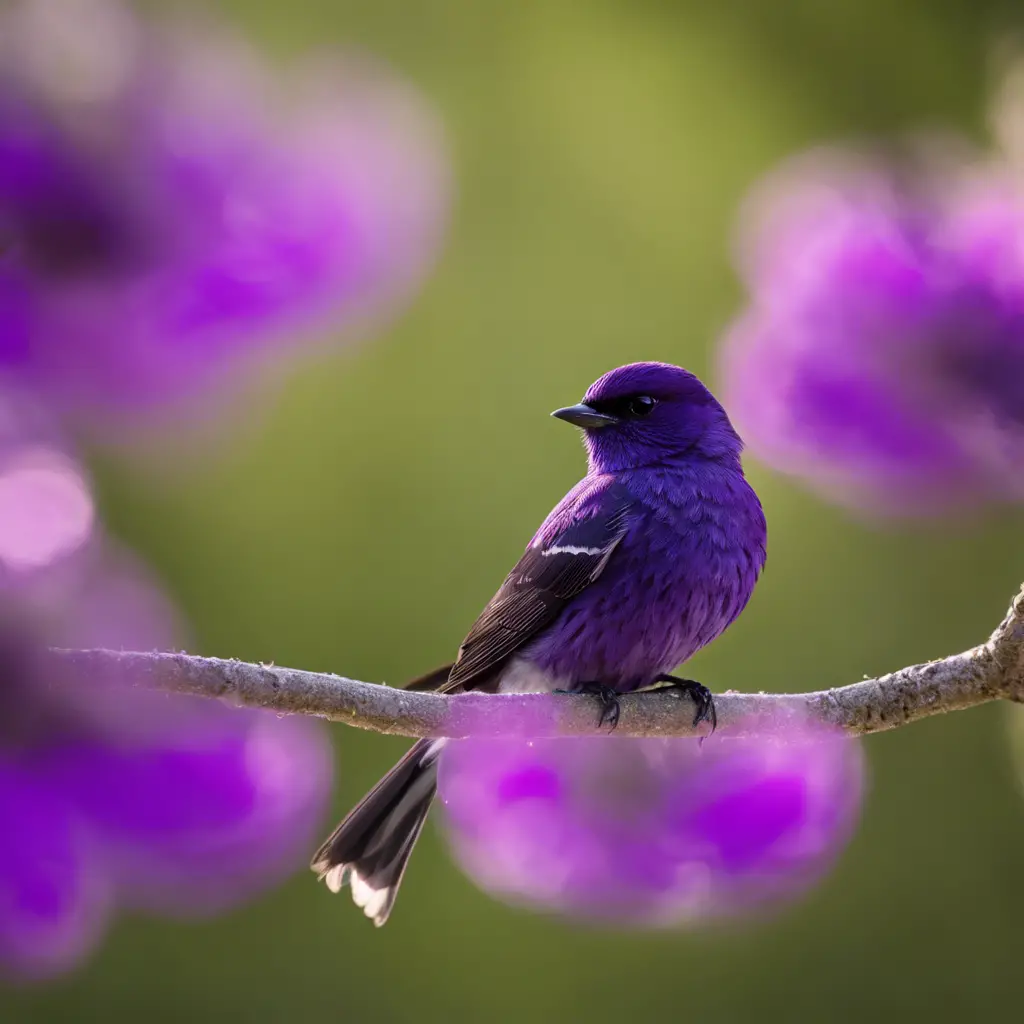You’ll be amazed by the vibrant array of yellow birds that grace the skies of Pennsylvania.
From the American Goldfinch and House Finch to the Yellow Warbler and Common Yellowthroat, these avian wonders bring a burst of color to the state.
Keep an eye out for the striking Yellow-breasted Chat, the melodious Eastern Meadowlark, and the elegant Orchard and Baltimore Orioles.
Don’t forget the American Redstart, a true gem in Pennsylvania’s birding scene.
Get ready to explore and discover the beauty of yellow birds in Pennsylvania.
Key Takeaways
- The state of Pennsylvania is home to several species of yellow birds, including the American Goldfinch, House Finch, Yellow Warbler, Common Yellowthroat, Yellow-breasted Chat, and Yellow-rumped Warbler.
- Warblers, a type of small songbird, are also found in Pennsylvania and include species such as the Worm-eating Warbler, Hooded Warbler, Kentucky Warbler, Magnolia Warbler, Black-throated Green Warbler, Chestnut-sided Warbler, Canada Warbler, and American Redstart.
- Orioles, another group of colorful birds, can be found in Pennsylvania, including the Orchard Oriole and Baltimore Oriole.
- Understanding the migration patterns of yellow birds, such as the Yellow Warbler, Chestnut-sided Warbler, and Canada Warbler, is important for conservation efforts and studying their behavior. Additionally, conservation efforts are being made for species like the Common Yellowthroat, Yellow-breasted Chat, and Chestnut-sided Warbler, while the Prothonotary Warbler has a specific conservation status.
American Goldfinch
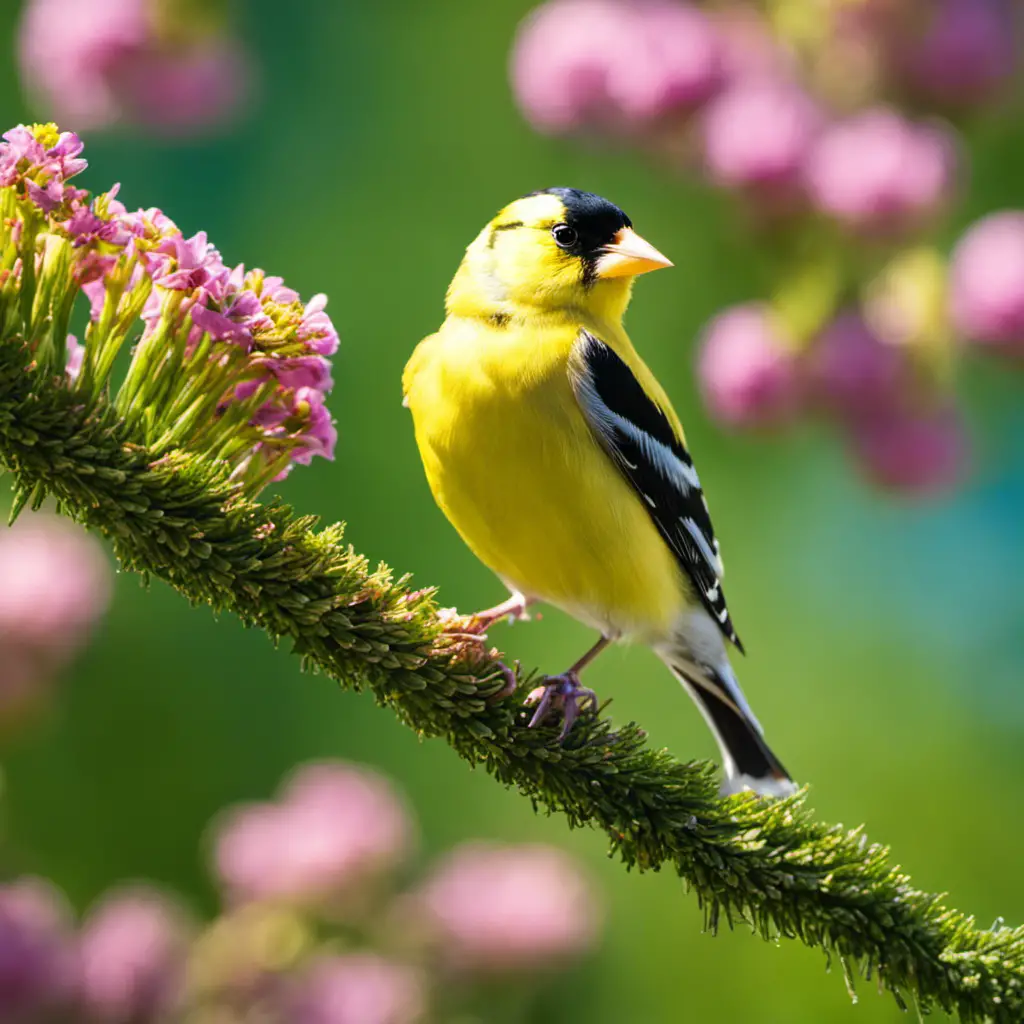
You really should check out the American Goldfinch, they’re quite stunning! American Goldfinches, known scientifically as Spinus tristis, are small songbirds that are easily recognizable by their bright yellow plumage and black wings. They’ve a conical beak that’s perfect for extracting seeds from plants, their preferred diet.
American Goldfinches are highly social birds and can often be found in flocks, especially during the breeding season. They’re known for their unique nesting behaviors, building their nests in the branches of trees using plant fibers and animal hairs.
These birds play an important role in the ecosystem as well. They help control weed populations by feeding on the seeds of various plants, and their nests provide shelter and protection for other small birds.
House Finch
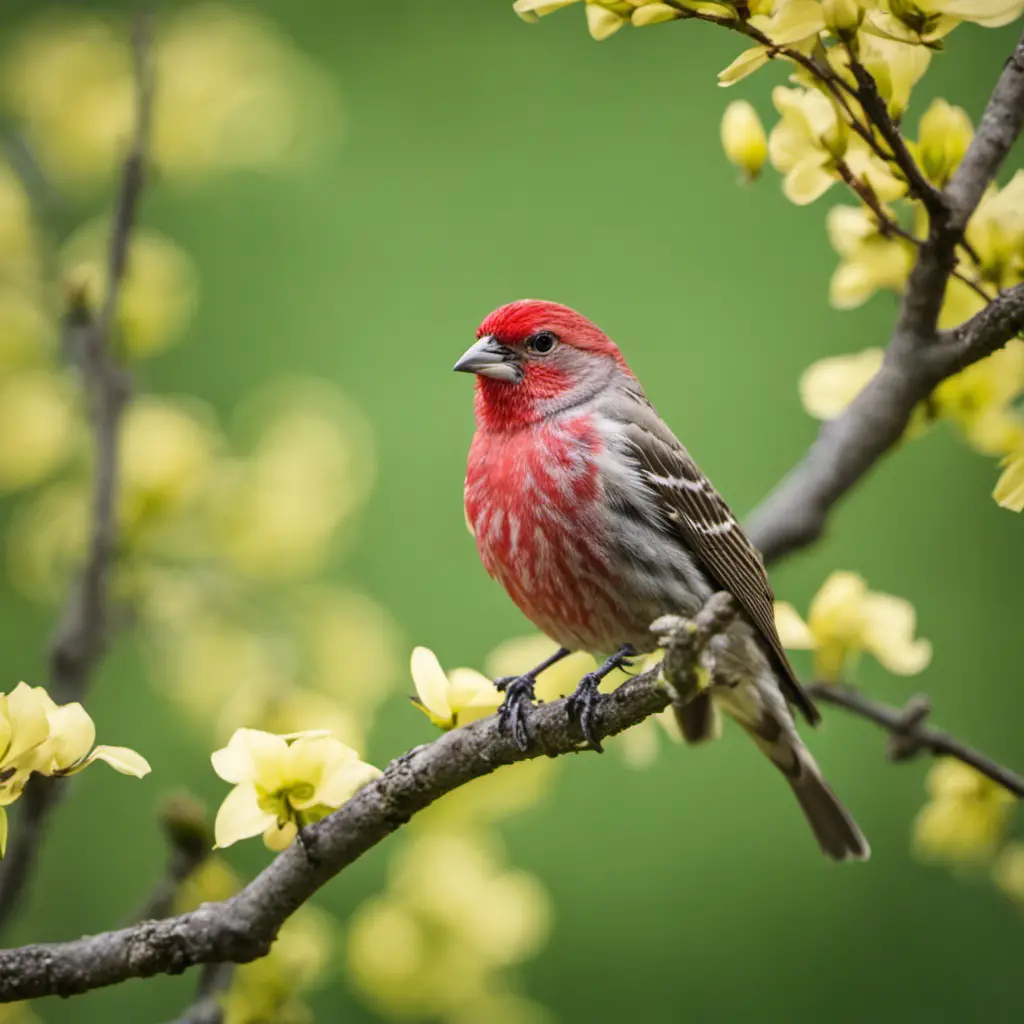
Take a look at the House Finch – they’re known for their vibrant red plumage and melodious songs. House Finches are common birds found throughout North America, including urban areas like parks and gardens. Their habitat includes a range of environments, from forests to deserts, but they’re particularly well-adapted to living near humans. They often build their nests in trees, shrubs, or even on man-made structures such as buildings or hanging planters.
When it comes to their diet, House Finches primarily feed on seeds, especially those of plants like sunflowers, dandelions, and thistles. They’ve a specialized bill that allows them to crack open seeds and extract the nutritious contents. In addition to seeds, they also consume some fruits and insects, particularly during the breeding season when they need extra protein for their growing chicks.
Overall, the House Finch is a versatile bird that can thrive in various habitats and has a diverse diet, making it a successful species in both natural and human-altered environments.
Yellow Warbler
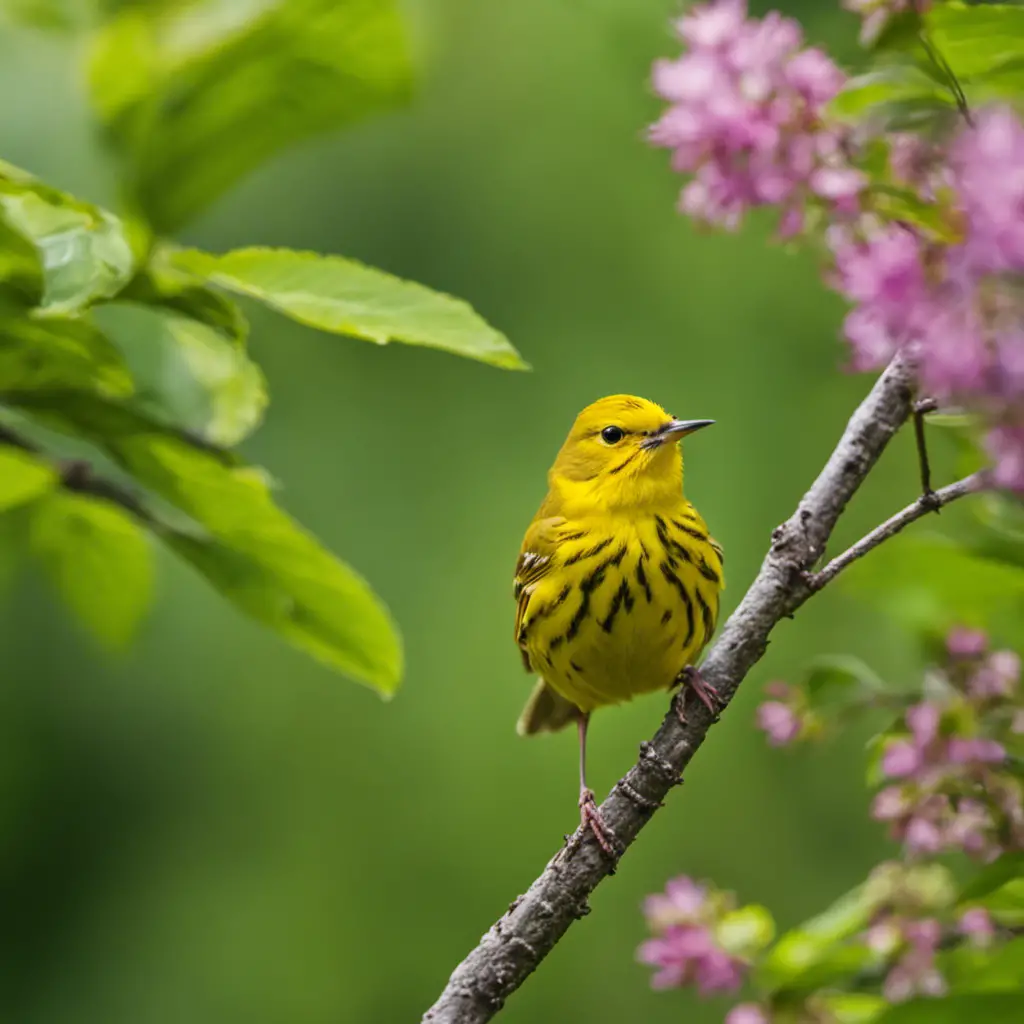
Check out the Yellow Warbler – they’re known for their bright yellow feathers and cheerful songs. These small migratory birds can be found in North America, including Pennsylvania. Here are some fascinating facts about their migration patterns and nesting habits:
Migration Patterns: Yellow Warblers are long-distance migrants, traveling from their breeding grounds in North America to their wintering grounds in Central and South America. They make this journey twice a year, covering thousands of miles.
Timing: These birds typically arrive in Pennsylvania around late April or early May for breeding. They spend their summers here, building nests and laying eggs. In early fall, they start their migration southward.
Nesting Habits: Yellow Warblers build their nests in shrubs and trees, often near water sources. The female constructs a cup-shaped nest using grass, bark, and spider silk, lined with soft materials like feathers and plant down.
Parental Care: Once the eggs hatch, both parents take turns feeding and caring for the chicks. The young birds fledge after about 10 days and become independent shortly after.
Observing these beautiful birds during their migration and nesting seasons can provide valuable insights into their behavior and contribute to our understanding of their ecology.
Common Yellowthroat
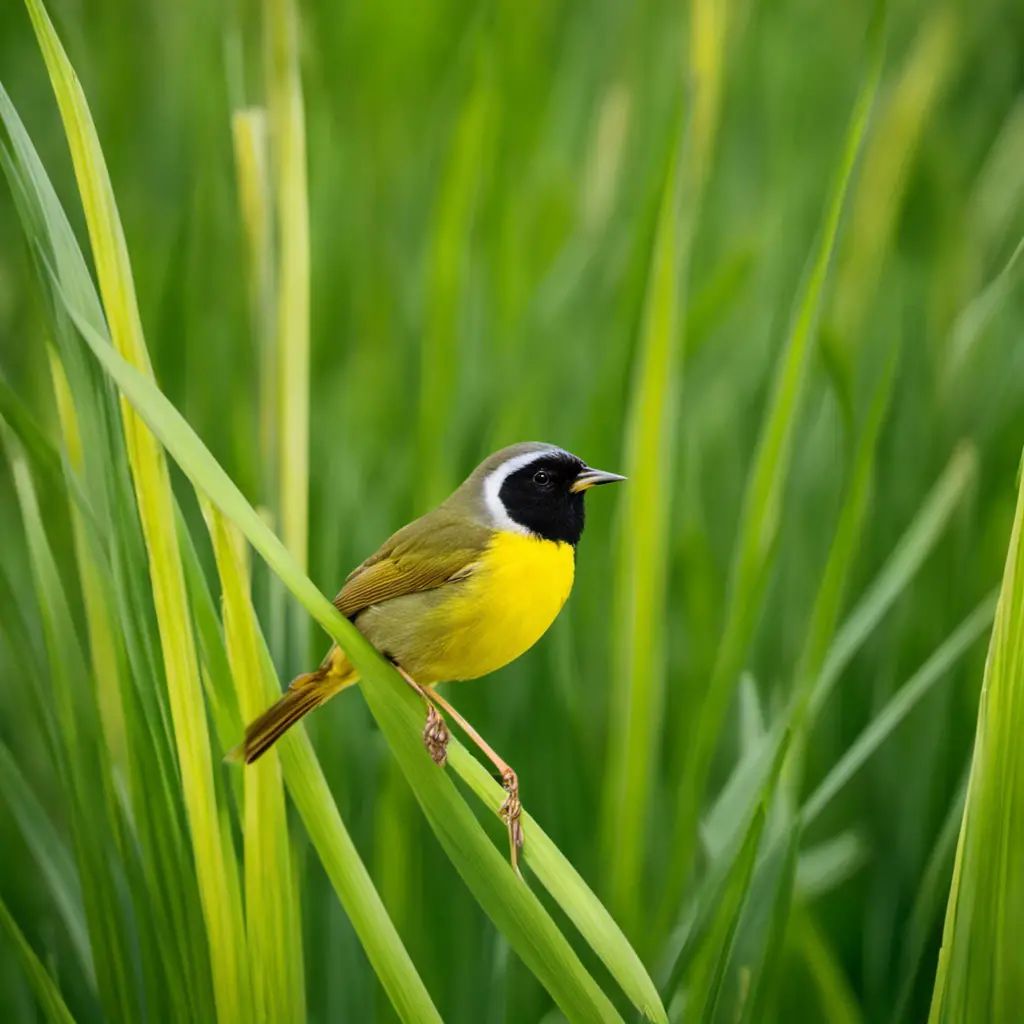
Listen closely, for the Common Yellowthroat is known for its distinctive call and secretive nature. This small migratory bird, scientifically known as Geothlypis trichas, is a member of the warbler family and can be found throughout North America.
The Common Yellowthroat is easily identified by its bright yellow throat and olive-green body. It prefers habitats such as wetlands, marshes, and thickets with dense vegetation, where it can hide and forage for insects and spiders.
However, due to habitat loss and degradation, the population of Common Yellowthroats is declining, raising concerns about their conservation status. Efforts are being made to protect and restore their habitats, such as the creation of wetland reserves and the preservation of suitable breeding grounds.
Conservation organizations are also working to raise awareness about the importance of these habitats and the need to protect them for the survival of this beautiful species.
Yellow-breasted Chat
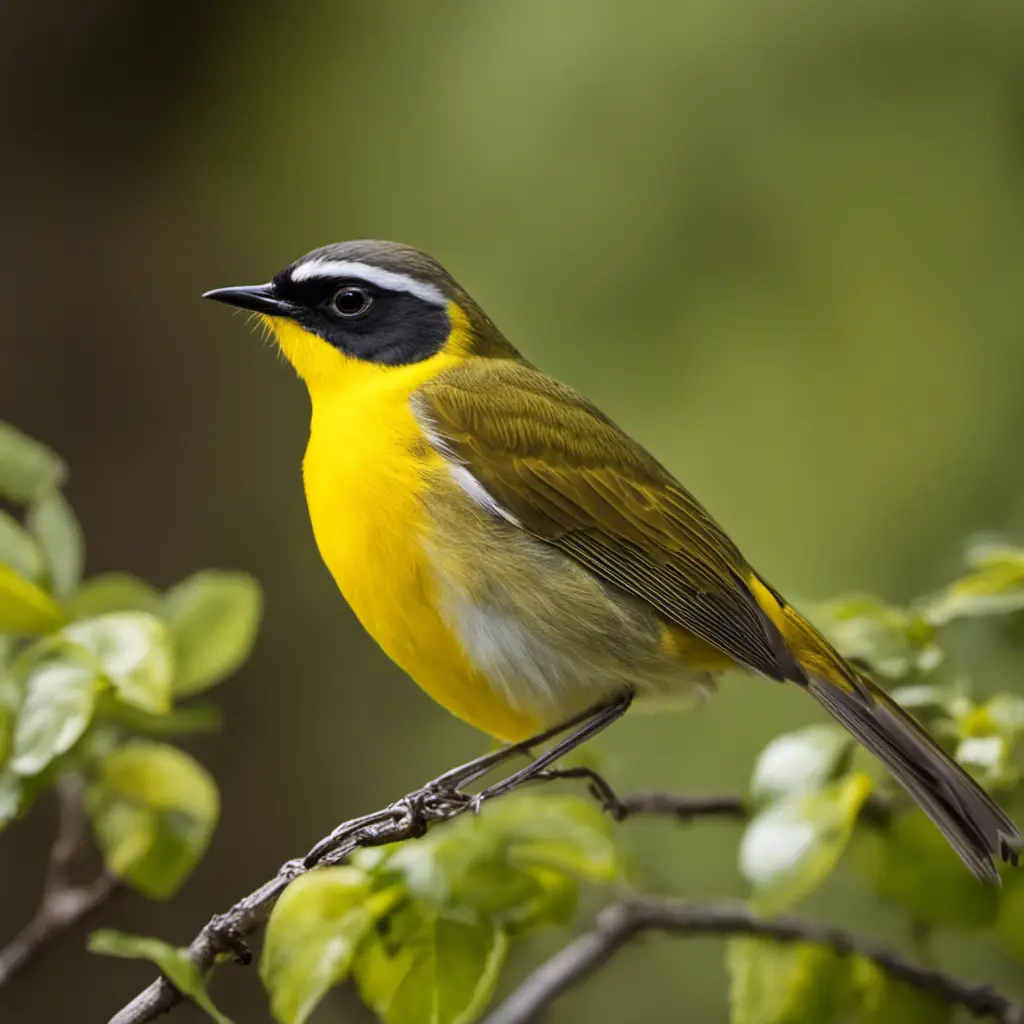
Have you ever seen a Yellow-breasted Chat in person? These unique birds are known for their vibrant yellow chest and their loud and varied vocalizations. Here are four interesting facts about Yellow-breasted Chats:
Breeding Habits: Yellow-breasted Chats are found in dense thickets and shrubby areas across North America, including parts of Pennsylvania. They prefer habitats with a mix of trees, shrubs, and open spaces. During breeding season, males establish territories and perform elaborate courtship displays to attract females.
Vocalizations: Yellow-breasted Chats are often referred to as the ‘mockingbirds of the forest’ due to their impressive repertoire of songs and calls. Their vocalizations include a mix of whistles, trills, chuckles, and even mimicry of other bird species. They’re known for their ability to imitate various sounds, including the songs of other birds and even mechanical noises.
Nesting Behavior: Yellow-breasted Chats build their nests in low shrubs or on the ground, using twigs, grasses, and leaves. The nests are often well-hidden and difficult to spot. Females lay a clutch of 3-5 eggs, which they incubate for about two weeks. Both parents participate in feeding and caring for the chicks.
Conservation Status: While Yellow-breasted Chats are still relatively common in some parts of their range, their populations have declined in recent years due to habitat loss. Conservation efforts are being made to protect and restore their preferred habitats, which are vital for their breeding and nesting success.
Yellow-rumped Warbler
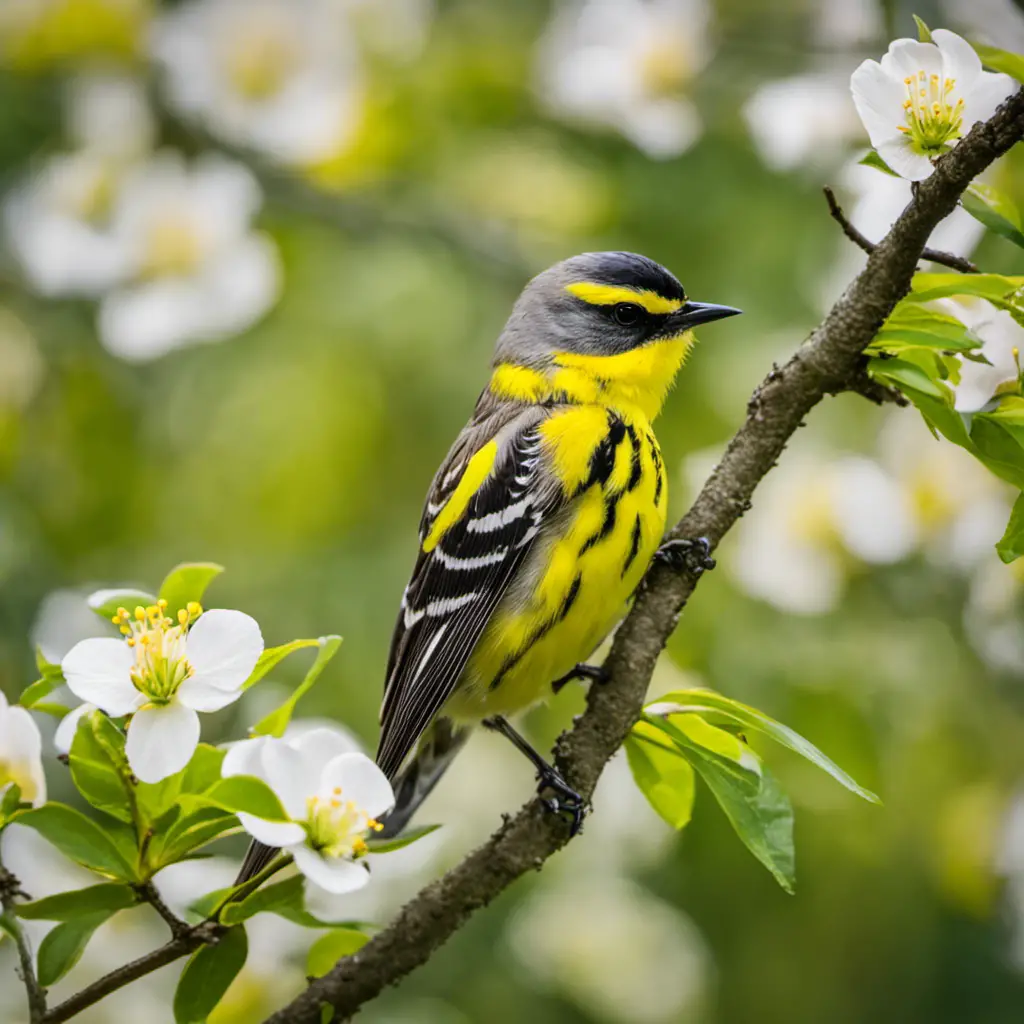
Do you enjoy watching the Yellow-rumped Warbler flitting through the trees, searching for insects to eat?
The Yellow-rumped Warbler, also known as the Myrtle Warbler, is a migratory bird that can be found across North America. In Pennsylvania, these birds can be seen during their spring and fall migration periods. They’re known for their distinct yellow rumps, which are visible even from a distance.
During migration, these warblers rely on a variety of food sources, including insects, berries, and fruits. They’ve a unique feeding behavior of hovering and catching insects mid-air. In addition, they’re also known to forage on the ground, searching for insects among fallen leaves.
Understanding the yellow-rumped warbler’s migration patterns and feeding habits can provide valuable insights into their ecology and conservation.
Yellow-throated Warbler
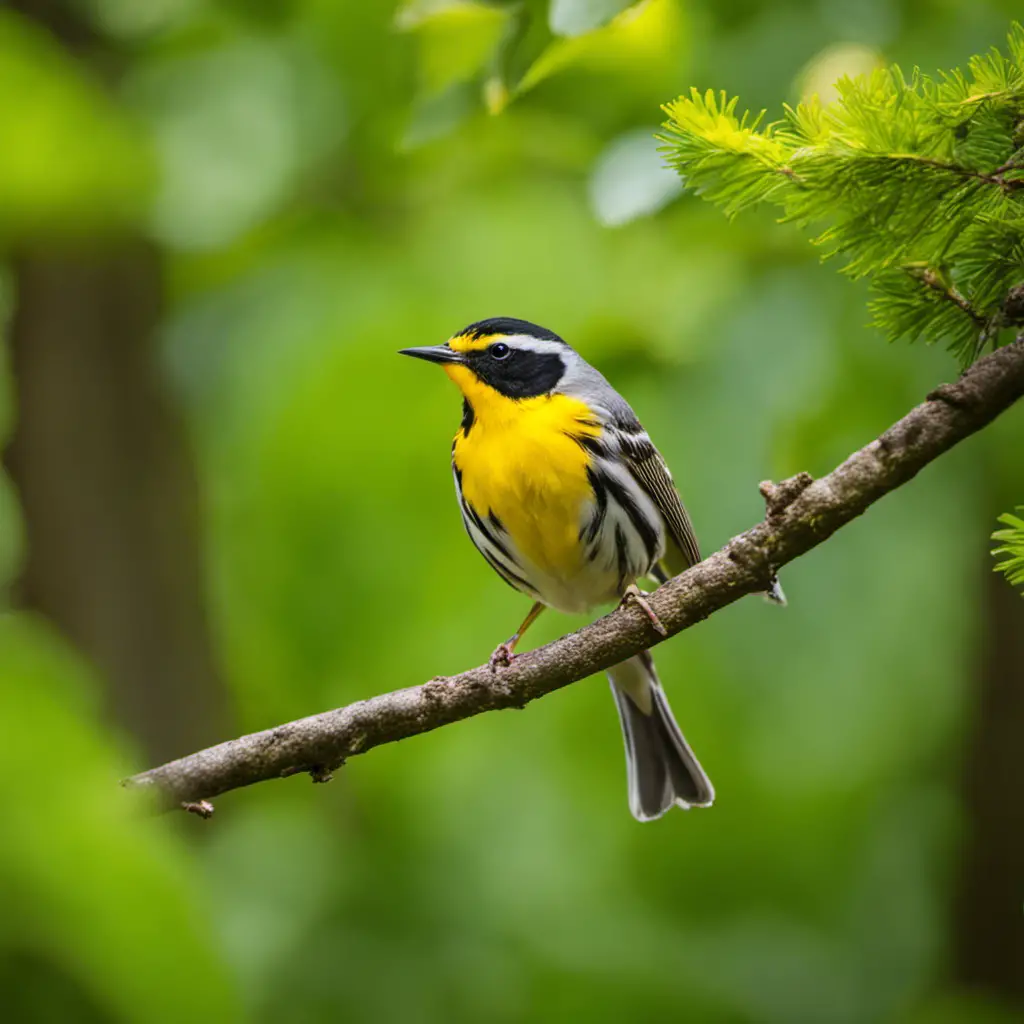
Are you familiar with the Yellow-throated Warbler and its distinctive yellow throat, which sets it apart from other warbler species? This beautiful bird, scientifically known as Setophaga dominica, is a migratory species that can be found in the eastern parts of North America.
Here are some key points to understand about Yellow-throated Warblers:
Migration Patterns: These warblers breed in the southeastern United States and then migrate to Central America and the Caribbean during the winter months.
Habitat Preferences: They prefer mature deciduous forests with a dense canopy and tall trees near bodies of water, such as rivers or swamps.
Feeding Habits: Yellow-throated Warblers primarily feed on insects, including ants, beetles, and caterpillars. They also consume spiders and occasionally fruits.
Conservation Status: While they aren’t currently listed as a threatened or endangered species, habitat loss due to deforestation could pose a threat to their population in the future.
Understanding the Yellow-throated Warbler’s migration patterns and habitat preferences is crucial for conserving this species and ensuring its survival in the wild.
Pine Warbler
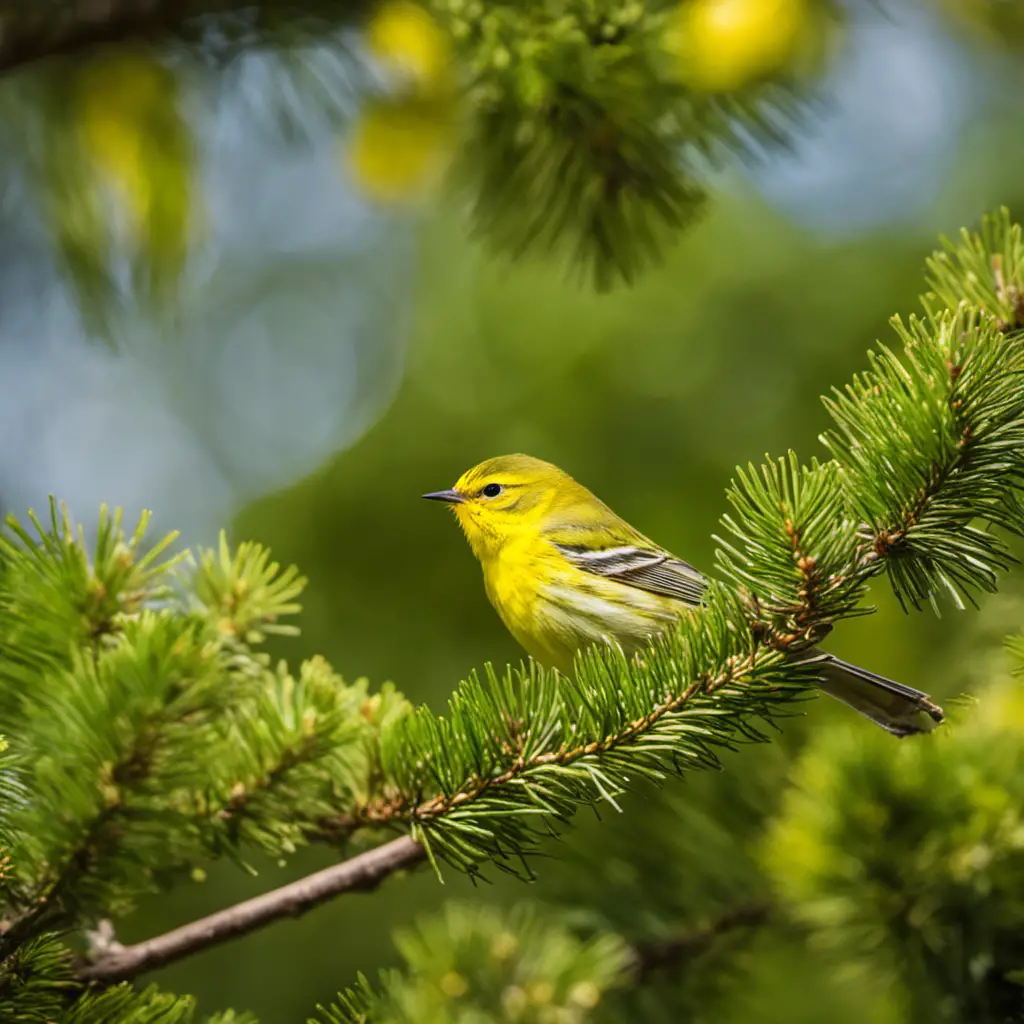
Can you spot the Pine Warbler in the tall pine trees?
The Pine Warbler (Setophaga pinus) is a small songbird that can be found in the eastern parts of North America. During migration, these birds travel from their breeding grounds in the northern United States and Canada to their wintering grounds in the southeastern states.
They prefer to inhabit mature pine forests, where they forage for insects and spiders among the pine needles and branches. The Pine Warbler’s plumage is mainly olive-green, with a yellow throat and chest. It has a distinctive song, a series of musical trills and warbles.
These birds are known for their ability to camouflage among the pine trees, making them sometimes difficult to spot. Keep an eye out for their yellow plumage and listen for their unique songs when exploring pine forests.
Prairie Warbler
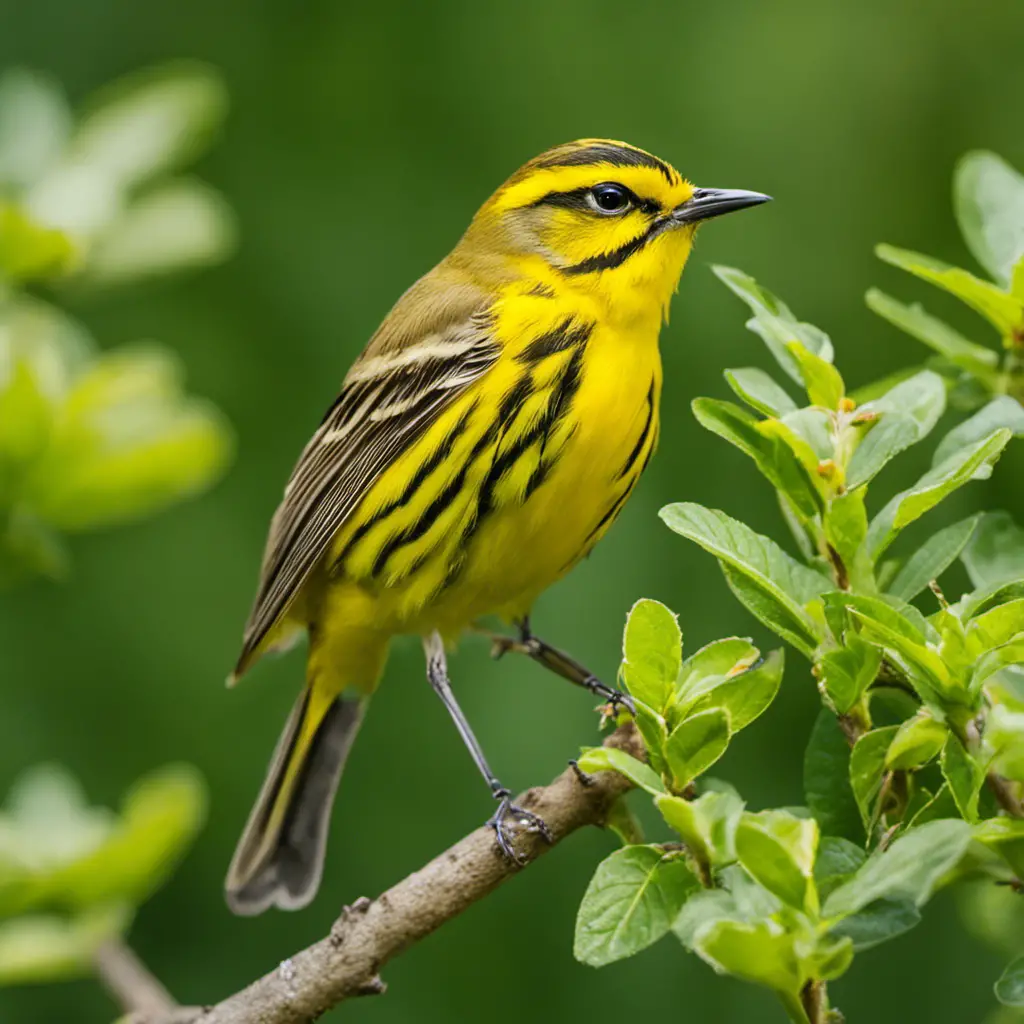
Have you seen the Prairie Warbler’s vibrant yellow plumage in the Pennsylvania prairies? These beautiful birds are a sight to behold, with their bright yellow feathers contrasting against the green foliage.
Here are four fascinating facts about the Prairie Warbler:
Habitat: Prairie Warblers are primarily found in shrubby habitats, such as young forests, old fields, and shrublands. They prefer areas with a mix of trees, shrubs, and grasses, as these provide them with suitable nesting sites and abundant food sources.
Migration Patterns: Prairie Warblers are neotropical migrants, which means they migrate between their breeding grounds in North America and their wintering grounds in the Caribbean and Central America. They undertake long-distance migrations, traveling thousands of miles each year.
Nesting Behavior: These birds build cup-shaped nests near the ground, typically hidden in dense vegetation. The female Prairie Warbler constructs the nest using grasses, twigs, and plant fibers, while the male assists by bringing materials.
Diet: Prairie Warblers primarily feed on insects and spiders. They forage actively in shrubs and low vegetation, gleaning insects from leaves and branches or catching them in mid-air.
Understanding the habitat preferences and migration patterns of Prairie Warblers is crucial for their conservation and ensuring their continued presence in the Pennsylvania prairies.
Prothonotary Warbler
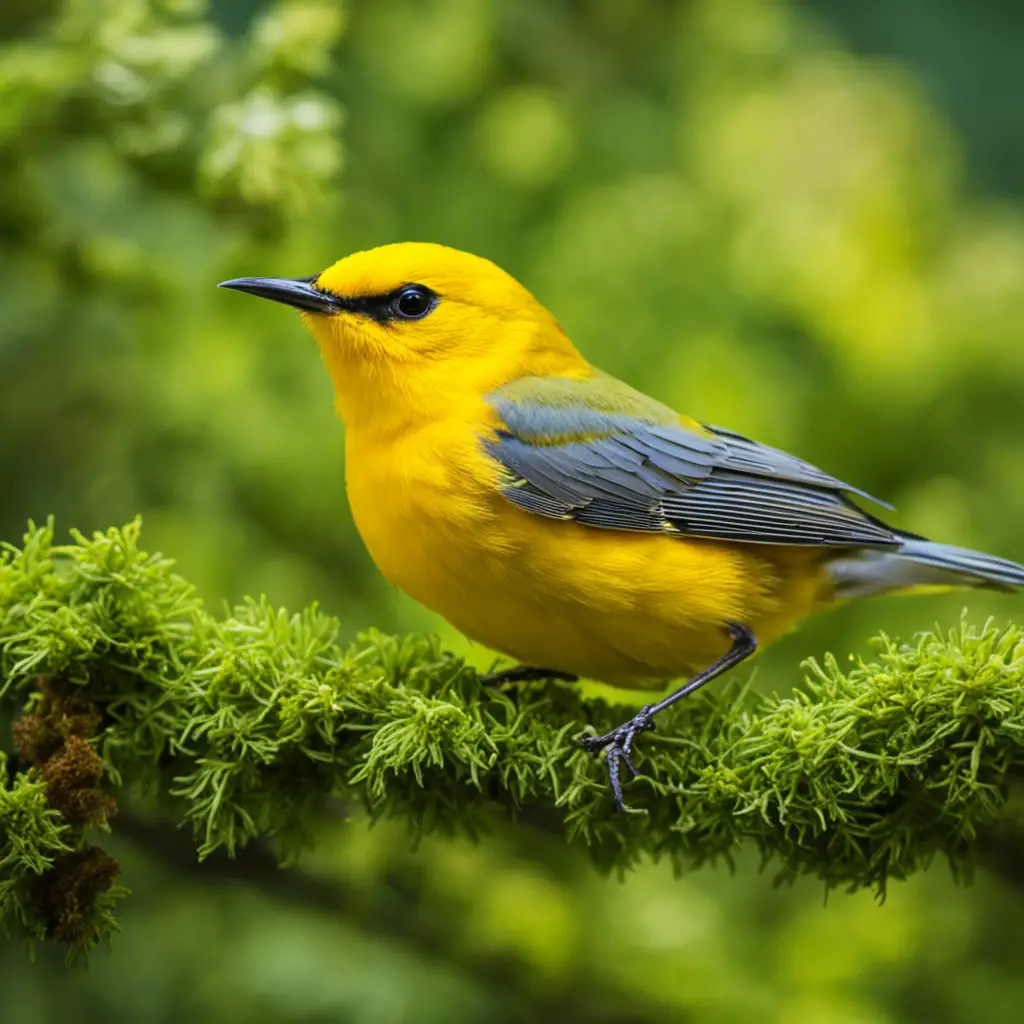
Do you know where to find the Prothonotary Warbler in Pennsylvania? This small, vibrantly yellow bird can be spotted in wetland habitats throughout the state. The Prothonotary Warbler, also known as the "Golden Swamp Warbler," is an important species to study for both conservation and breeding behavior research.
| Prothonotary Warbler Facts | |
|---|---|
| Scientific Name | Protonotaria citrea |
| Conservation Status | Near Threatened |
| Breeding Behavior | Monogamous, cavity nesters |
Conservation efforts for the Prothonotary Warbler are crucial due to its declining population. Loss of wetland habitats, deforestation, and competition with invasive species are some of the main threats these birds face. By studying their breeding behavior, researchers can better understand their reproductive success and develop strategies to protect their nesting sites.
To support Prothonotary Warbler conservation, it is important to protect and restore wetlands, maintain suitable nesting sites, and control invasive species. By implementing these conservation measures, we can ensure the survival of this beautiful and valuable species for future generations to enjoy.
Worm-eating Warbler
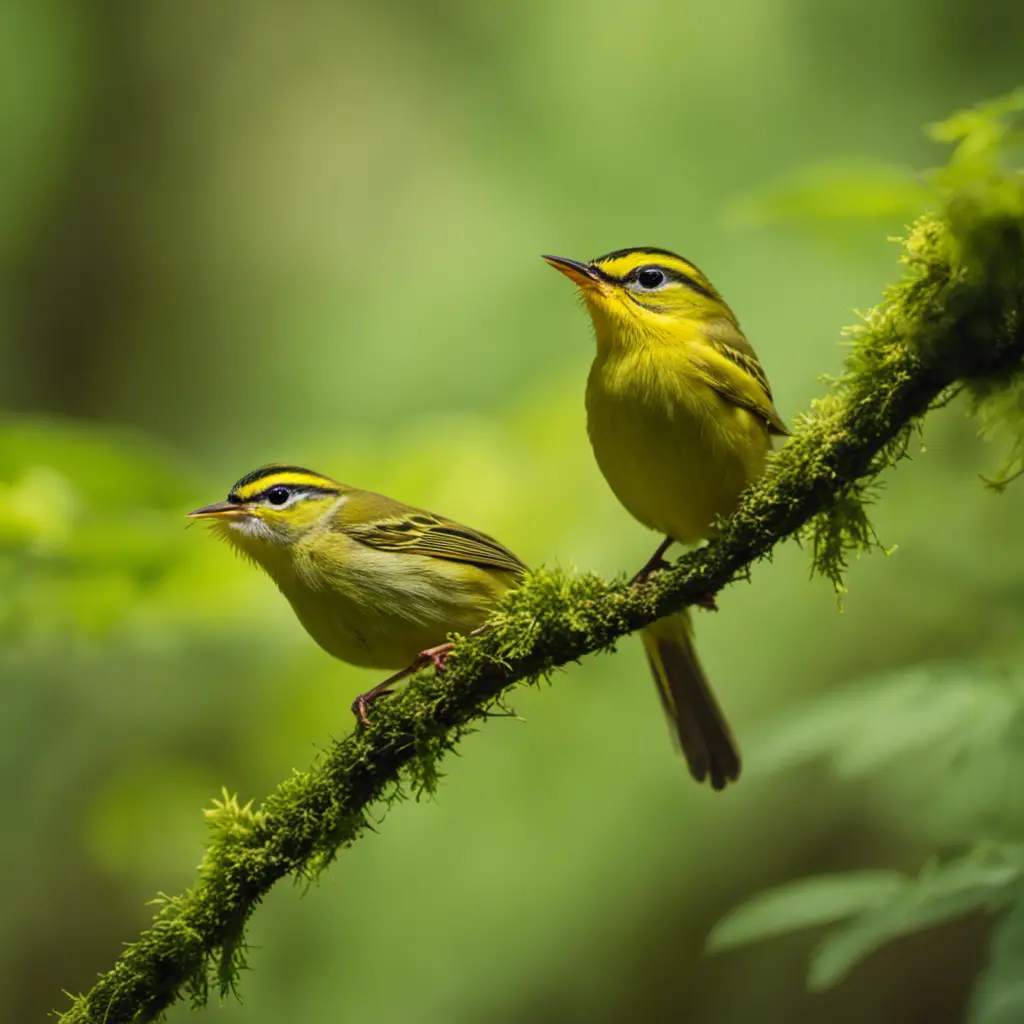
You can spot the Worm-eating Warbler in Pennsylvania during the breeding season, but only if you’re patient and observant. This small, yellow bird is known for its distinct habits and behavior. Here are four key facts about the Worm-eating Warbler:
Migration Patterns: The Worm-eating Warbler is a neotropical migrant, which means it travels long distances between breeding and wintering grounds. It breeds in the eastern United States, including Pennsylvania, and migrates to Central America and northern South America during the winter.
Nesting Habits: This warbler builds its nest on the ground, usually in dense thickets or under leaf litter. The nest is cup-shaped and made of leaves, grasses, and twigs, providing a well-hidden and protected place for the eggs and chicks.
Diet: True to its name, the Worm-eating Warbler primarily feeds on insects, especially caterpillars and spiders. It forages by hopping along the ground or climbing on low vegetation, using its sharp bill to extract prey from leaf litter and tree bark.
Behavior: The Worm-eating Warbler is known for its secretive nature. It prefers to stay hidden in dense vegetation and is often heard before it’s seen. Its song is a high-pitched trill, which helps birdwatchers locate this elusive species.
Hooded Warbler
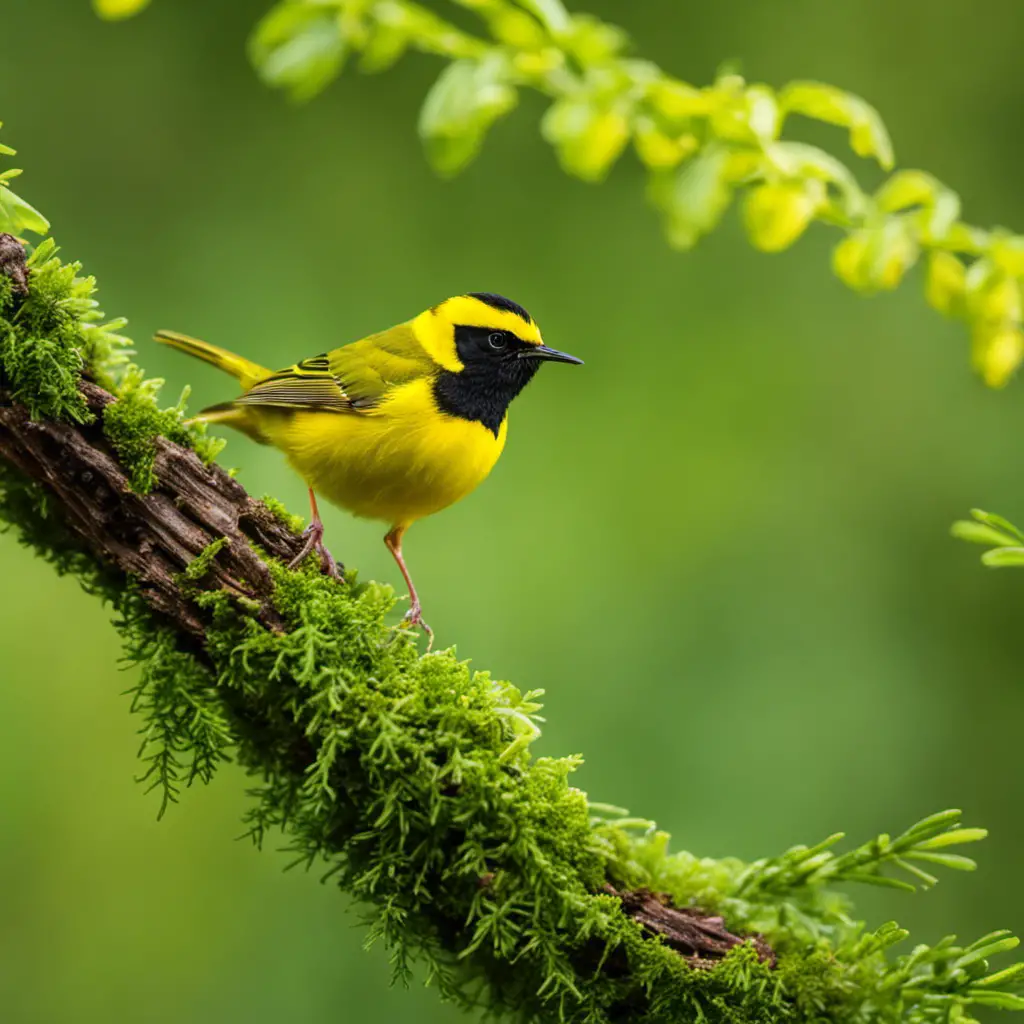
Listen closely to the melodious song of the Hooded Warbler as it echoes through the Pennsylvania woods. This small, migratory songbird is known for its vibrant yellow plumage and unique black hood.
The Hooded Warbler is mainly found in the eastern United States during the breeding season, where it prefers dense, shrubby habitats near streams or wetlands. During the winter months, these birds migrate to Central and South America, where they inhabit tropical forests.
Habitat loss and degradation due to deforestation are major threats to the Hooded Warbler’s population. Conservation efforts are crucial to protect and restore their habitats, ensuring their survival for future generations. By preserving the forests and wetlands that these birds rely on, we can help maintain their migration patterns and ensure the continued beauty of their melodious songs in the Pennsylvania woods.
Kentucky Warbler
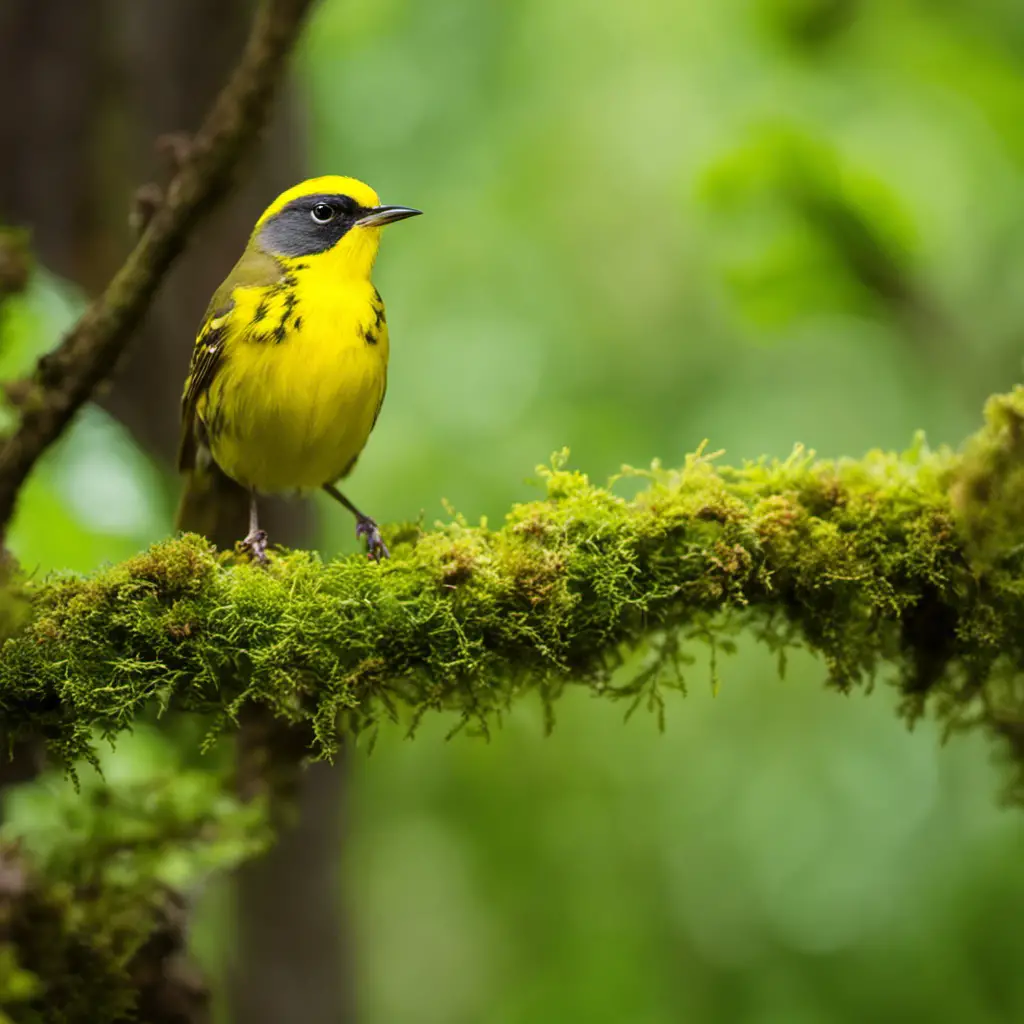
Take a moment to appreciate the Kentucky Warbler’s stunning yellow plumage and listen to its melodious song as it fills the forests of Pennsylvania. This secretive bird is a delight to observe, but its shy nature makes it challenging to spot.
Here are some fascinating facts about the Kentucky Warbler:
Habitat: The Kentucky Warbler prefers dense undergrowth in deciduous forests, where it can find cover and forage for insects.
Range: This species is primarily found in the southeastern United States, including parts of Kentucky, Tennessee, and West Virginia.
Behavior: Despite its secretive nature, the male Kentucky Warbler sings loudly to defend its territory and attract a mate.
Conservation: The Kentucky Warbler population is stable, but threats such as habitat loss and climate change may impact its future survival.
Magnolia Warbler
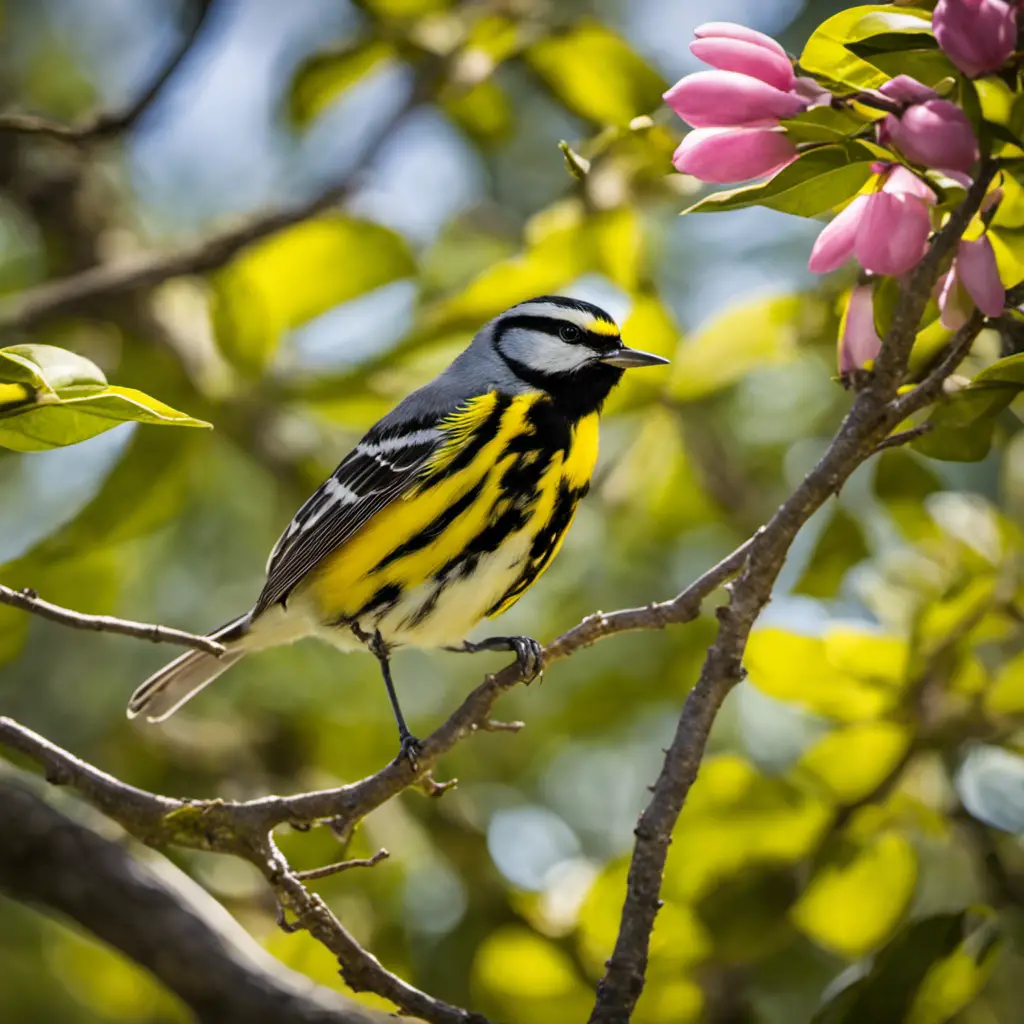
Spotting a Magnolia Warbler is a rare treat, but if you’re lucky, you might catch a glimpse of its vibrant yellow plumage and listen to its cheerful song. These small songbirds, scientifically known as Setophaga magnolia, are a delight to birdwatchers in North America. Magnolia Warblers are primarily found in the eastern part of the continent, especially during their breeding season from May to July. They prefer to make their homes in dense forests, particularly those with a mix of coniferous and deciduous trees. During the winter months, these warblers migrate south to Central America and the Caribbean, where they find suitable habitats in tropical forests and coffee plantations. To better understand the preferences and behaviors of Magnolia Warblers, let’s take a look at the table below:
| Magnolia Warbler Habitat | Magnolia Warbler Migration Patterns |
|---|---|
| Dense forests | May to July |
| Mix of trees | Central America, Caribbean |
| Coniferous and deciduous | Tropical forests, coffee plantations |
Black-throated Green Warbler
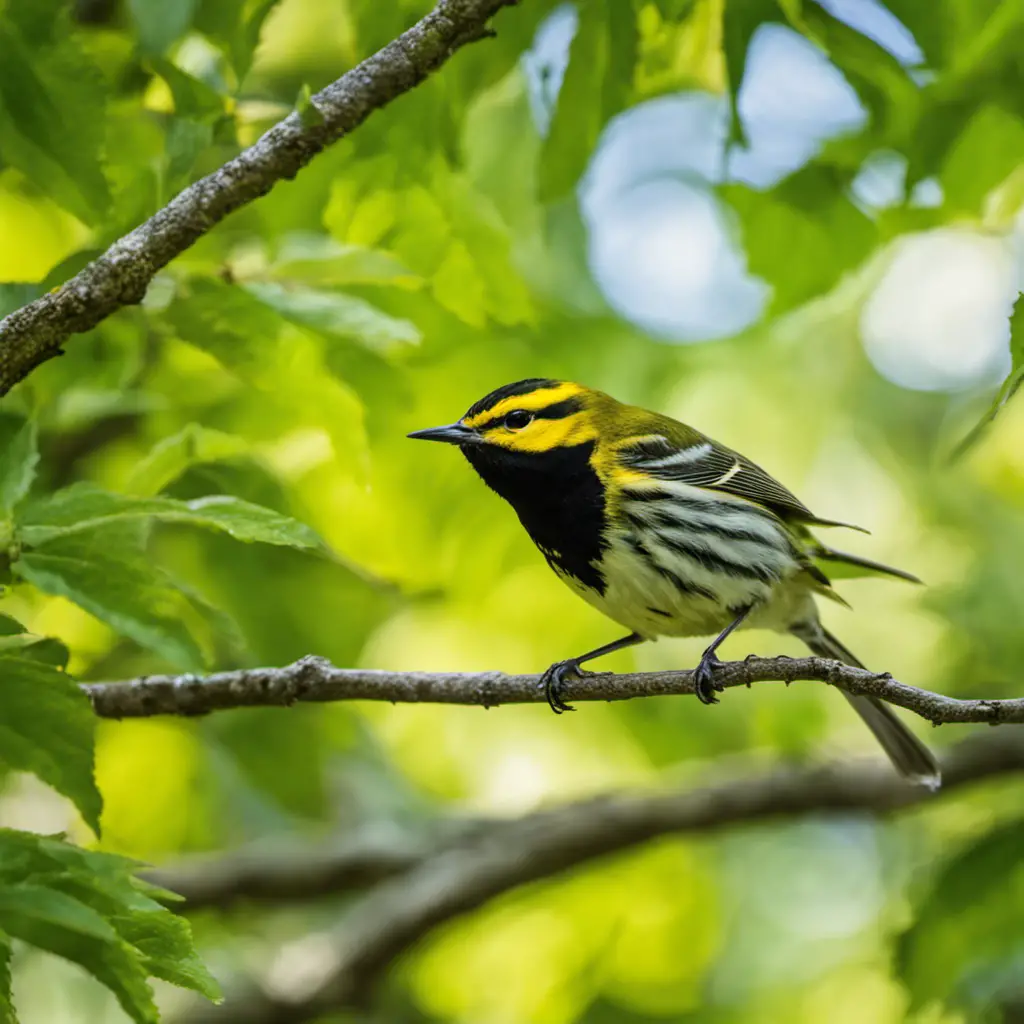
If you’re lucky, you might catch a glimpse of the Black-throated Green Warbler’s vibrant plumage as it flits among the trees. This small songbird, scientifically known as Setophaga virens, is a common sight in North America during the breeding season.
Here are four key facts about the Black-throated Green Warbler:
Habitat: These warblers prefer to nest in mature deciduous and mixed forests, particularly those with a dense understory. They can also be found in coniferous forests and wooded swamps.
Migration Patterns: The Black-throated Green Warbler is a long-distance migrant, spending the breeding season in North America and then migrating to Central America and the Caribbean for the winter. They travel along the Atlantic coast and through the Gulf of Mexico, using stopover sites to rest and refuel.
Diet: These warblers mainly feed on insects, including caterpillars, beetles, and spiders. They forage actively among the foliage, searching for prey and occasionally hovering to catch insects on the wing.
Conservation: While the Black-throated Green Warbler isn’t currently considered threatened, habitat loss and fragmentation pose significant challenges to their population. Conservation efforts focus on preserving and restoring their preferred forest habitats.
Blackburnian Warbler
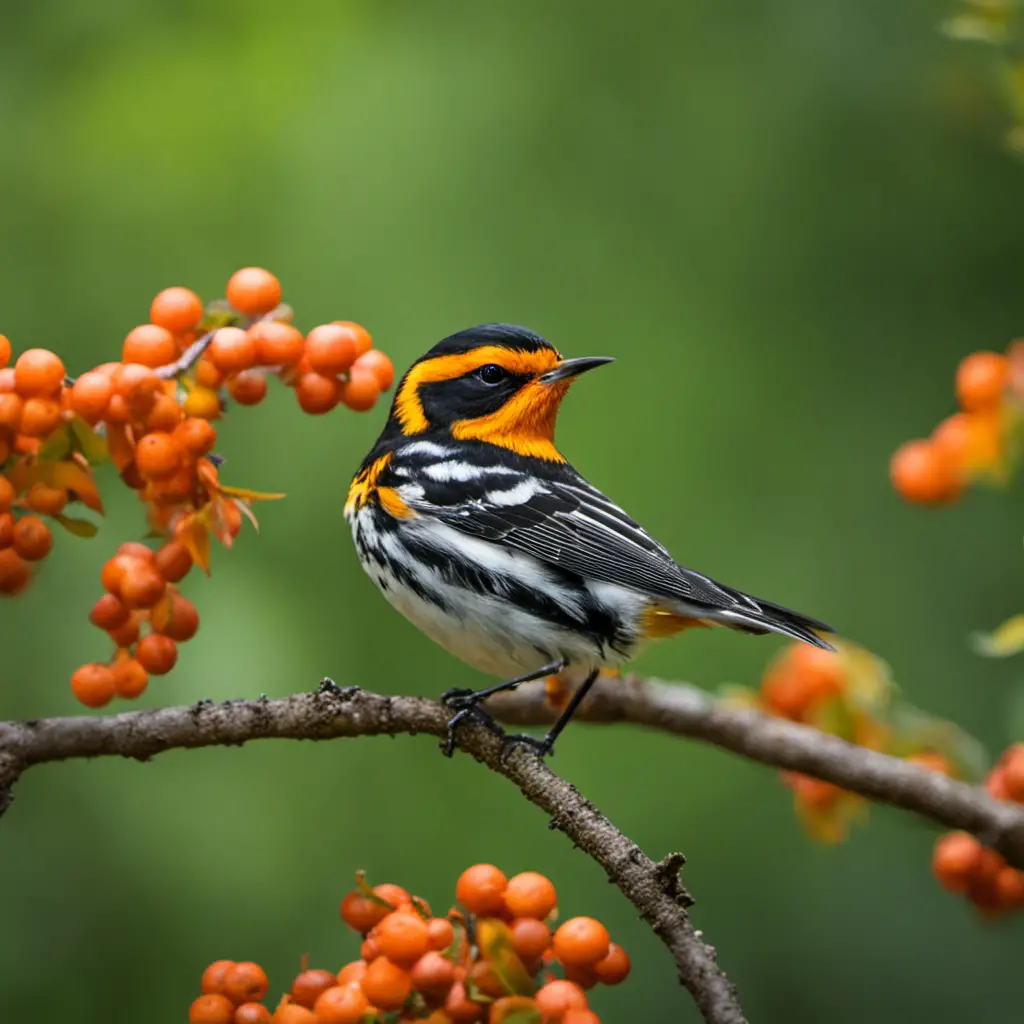
You can easily identify the Blackburnian Warbler by its striking orange throat and black and white plumage as it flutters through the treetops. This small songbird is known for its preference for coniferous forests, making it a common sight in the boreal forests of North America.
The Blackburnian Warbler breeds in the northern parts of the United States and Canada, where it constructs its nest on the branches of tall spruce and fir trees. In the winter, these birds undertake a remarkable migration, traveling to South America where they spend the colder months in the Andes Mountains.
The migration patterns of Blackburnian Warblers show a remarkable ability to navigate long distances, relying on a combination of innate instincts and environmental cues such as celestial navigation and magnetic fields. Understanding the habitat preferences and migration patterns of these birds is crucial for their conservation and management.
Chestnut-sided Warbler
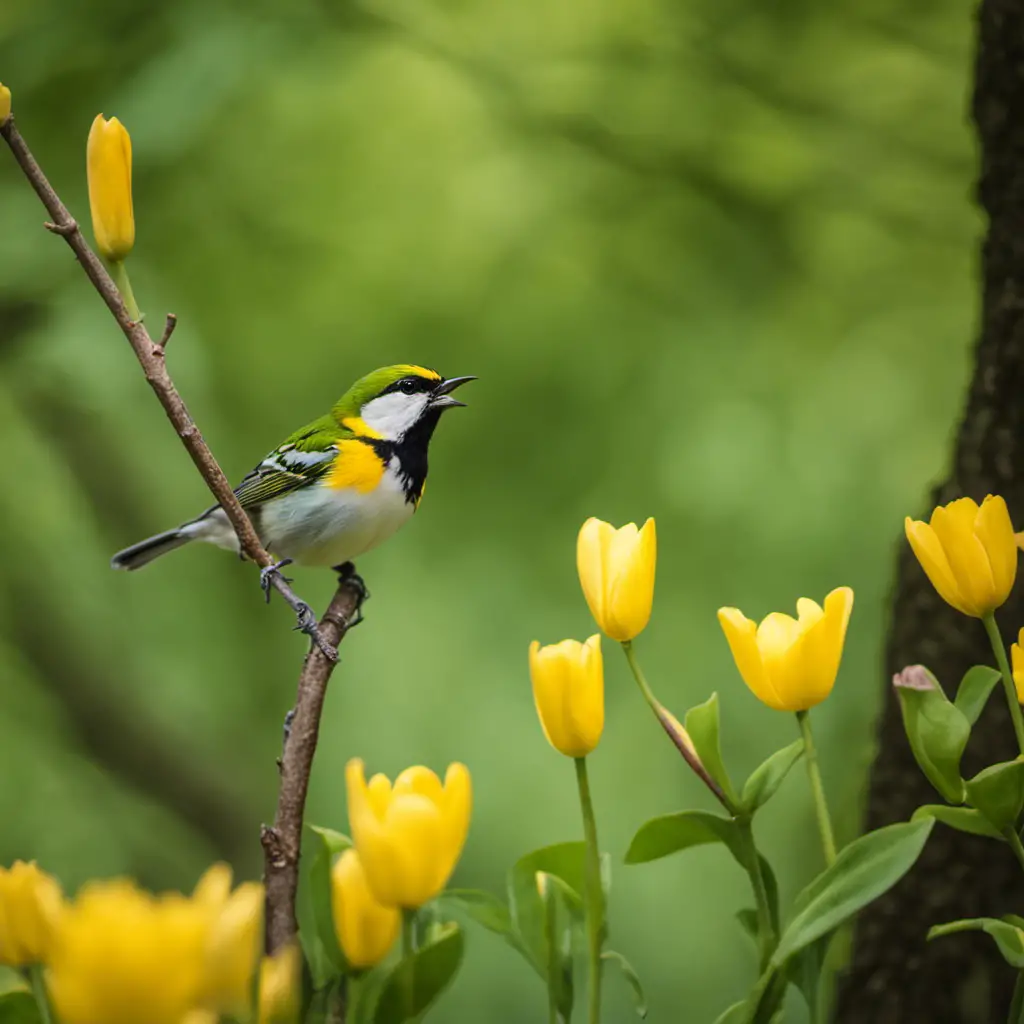
You can often find the Chestnut-sided Warbler foraging among the tree branches, singing its melodic song. This small migratory bird is known for its vibrant yellow plumage, with chestnut-colored streaks on its sides, giving it its name.
Here are four fascinating facts about the Chestnut-sided Warbler:
Bird Migration: The Chestnut-sided Warbler is a neotropical migrant, breeding in North America during the summer and then migrating to Central and South America for the winter. It undertakes long journeys, flying thousands of miles to reach its wintering grounds.
Breeding Habits: During the breeding season, male Chestnut-sided Warblers establish territories and attract mates through their distinctive songs. They build cup-shaped nests in shrubs or low tree branches, where the female lays her eggs.
Diet: These warblers primarily feed on insects, including spiders, caterpillars, and beetles. They use their sharp beaks to probe crevices and foliage for their prey.
Conservation Status: The Chestnut-sided Warbler is currently listed as a species of least concern by the International Union for Conservation of Nature (IUCN). However, habitat loss and climate change could pose future threats to their populations.
Canada Warbler
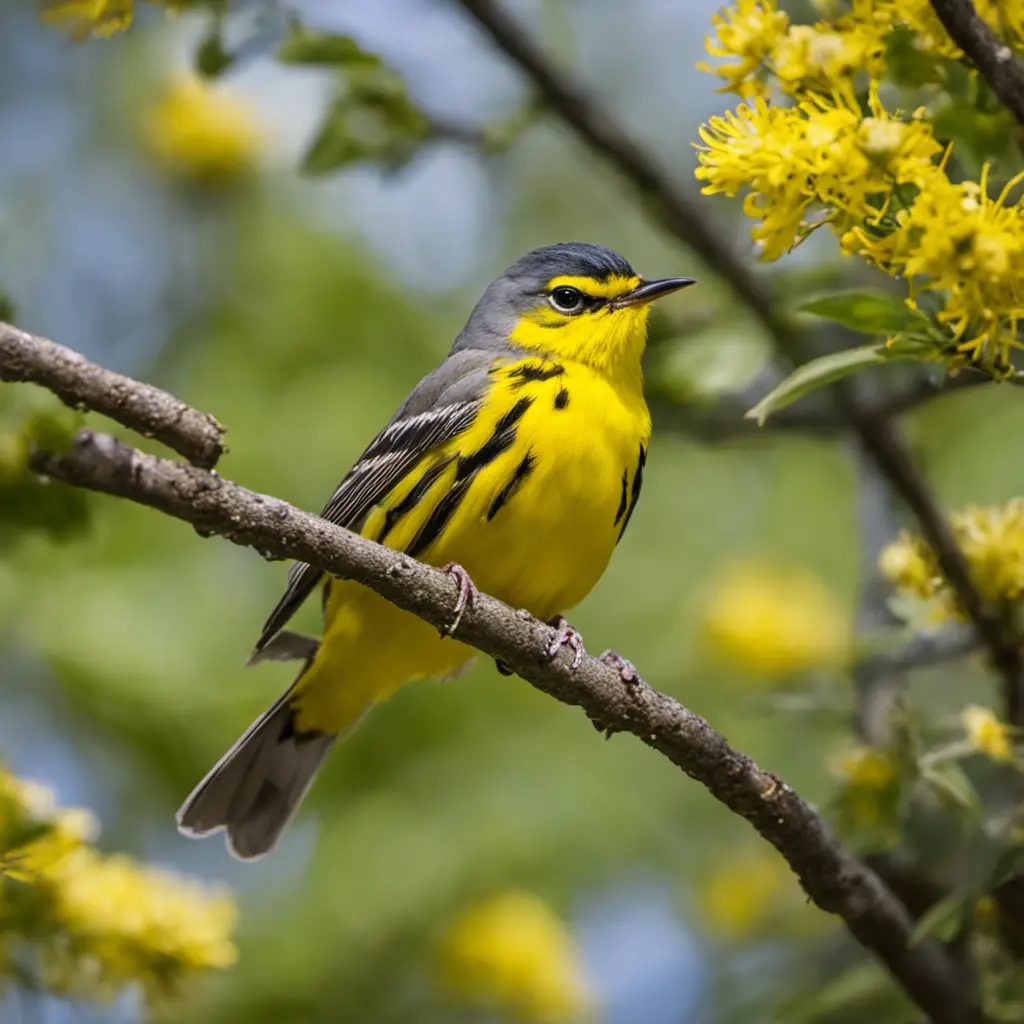
You’ll be amazed by the striking appearance and melodic song of the Canada Warbler, as it charms birdwatchers with its vibrant yellow plumage and distinctive black necklace.
This small songbird, scientifically known as Cardellina canadensis, is a neotropical migrant that breeds in the boreal forests of Canada and the northeastern United States.
The Canada Warbler’s conservation status is of concern due to habitat loss in both its breeding and wintering grounds. Efforts are being made to protect and restore these habitats to ensure the survival of this species.
During its migratory journey, the Canada Warbler travels thousands of kilometers, crossing the Gulf of Mexico to reach its wintering grounds in South America.
Studying the migration patterns of Canada Warblers helps researchers understand their behavior, population dynamics, and potential threats they may encounter along their route.
Wilson’s Warbler
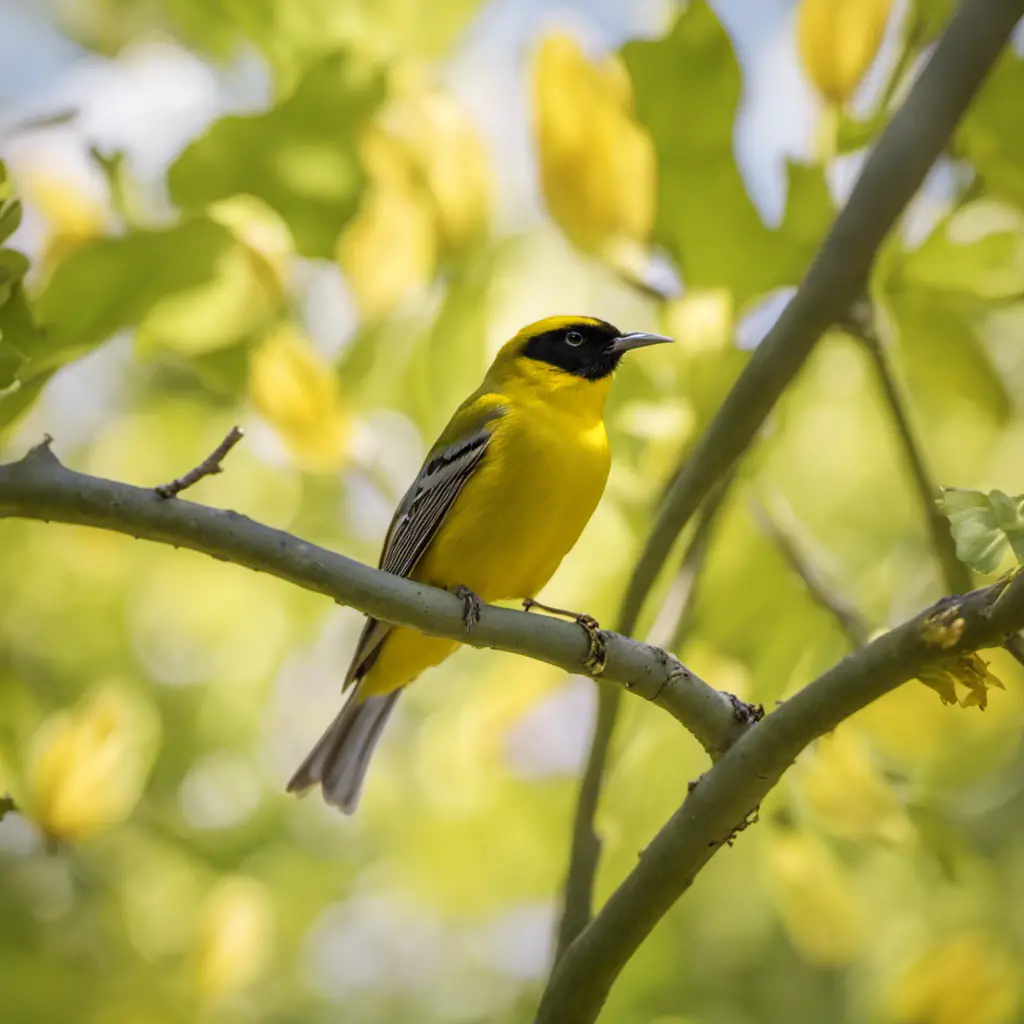
Don’t miss the opportunity to spot a Wilson’s Warbler during your birdwatching adventures in Pennsylvania. These small, vibrant birds are known for their bright yellow plumage and distinctive black caps.
Here are four fascinating facts about Wilson’s Warblers:
Migration Patterns: Wilson’s Warblers breed in the western parts of North America, including Alaska and western Canada. During the winter months, they migrate to Central America and northern South America. Pennsylvania serves as an important stopover location for these birds during their spring and fall migrations.
Conservation Efforts: The Wilson’s Warbler population has been declining in recent years due to habitat loss and climate change. Conservation efforts are vital to protect their breeding grounds and stopover sites, ensuring their survival for future generations.
Breeding Behavior: These warblers build cup-shaped nests on or near the ground, usually in dense shrubs or low vegetation. They lay around 4-7 eggs and both parents take turns incubating them.
Diet: Wilson’s Warblers primarily feed on insects, spiders, and other small invertebrates. They forage in the understory of forests, hopping from branch to branch in search of food.
Northern Parula
If you’re lucky, you may also spot a Northern Parula during your birdwatching adventures in Pennsylvania. These small, vibrant birds are known for their striking yellow plumage and melodic songs. The Northern Parula is primarily found in deciduous and mixed forests, where they build their nests in the forks of tree branches. They prefer habitats with dense vegetation, such as oak, maple, and birch trees. During their migration, which typically occurs in spring and fall, Northern Parulas can be seen in various parts of Pennsylvania as they make their way to and from their breeding grounds in the northern United States and Canada. By understanding their habitat preferences and migration patterns, birdwatchers can increase their chances of encountering these beautiful birds in the wild.
| Northern Parula Habitat | Northern Parula Migration Patterns |
|---|---|
| Deciduous and mixed forests | Spring and fall migration |
| Dense vegetation | Breeding grounds in northern US |
| Oak, maple, and birch trees | Migration to Canada |
Yellow-billed Cuckoo
You can easily identify a Yellow-billed Cuckoo by its distinct call and secretive behavior. Here are four fascinating facts about the Yellow-billed Cuckoo’s migration patterns and nesting behavior:
Migratory Patterns: The Yellow-billed Cuckoo is a neotropical migrant, meaning it travels long distances between its breeding grounds in North America and its wintering grounds in Central and South America. These birds undertake an impressive journey, covering thousands of miles each year.
Timing of Migration: Yellow-billed Cuckoos typically arrive in their breeding grounds in Pennsylvania during late spring, around May. They spend the summer months breeding and raising their young before embarking on their southward migration in late summer or early fall.
Nesting Behavior: Yellow-billed Cuckoos are known for their unique nesting habits. They prefer to build their nests in dense vegetation, such as shrubs or trees, near water sources. The female cuckoo lays her eggs in the nest of other bird species, such as robins or mourning doves, a behavior known as brood parasitism.
Nesting Materials: When constructing their nests, Yellow-billed Cuckoos use a variety of materials, including twigs, grass, and leaves. The nest is often loosely built, providing camouflage and protection for the eggs and young chicks.
Eastern Meadowlark
Listen closely for the distinctive song of the Eastern Meadowlark as it sings from its perch in the grassy fields.
The Eastern Meadowlark, scientifically known as Sturnella magna, is a medium-sized bird found in North America. It’s known for its bright yellow breast with a black V-shaped pattern on its chest.
This species has a unique behavior of singing from elevated perches, such as fence posts or treetops, to mark its territory and attract mates. The Eastern Meadowlark prefers open grasslands, pastures, and meadows as its habitat.
It feeds mainly on insects, but also consumes seeds and fruits. Its strong bill is adapted for foraging on the ground, where it searches for food by probing the soil.
Understanding the behavior and habitat of the Eastern Meadowlark is crucial for conservation efforts and maintaining suitable environments for this beautiful bird species.
Orchard Oriole
Have you noticed the vibrant orange and black plumage of the Orchard Oriole as it perches among the branches of fruit trees? These small migratory birds are a sight to behold, especially during their breeding season in Pennsylvania.
Here are four interesting facts about the Orchard Oriole:
Appearance: Male Orchard Orioles have striking orange plumage on their underparts and black feathers on their head, back, and wings. Females, on the other hand, have a more subdued yellowish-green coloration.
Diet: These orioles primarily feed on insects, but they also enjoy indulging in nectar, fruit, and berries. They’ve a specialized brush-tipped tongue that helps them extract nectar from flowers.
Habitat: Orchard Orioles can be found in a variety of habitats, including open woodlands, orchards, and gardens. They prefer areas with a mix of trees and shrubs, where they can build their nests.
Comparison with Yellow Warbler: While both the Orchard Oriole and the Yellow Warbler have yellow plumage, they can be distinguished by their size and habitat preference. Orchard Orioles are slightly larger and tend to inhabit more wooded areas.
Observing these beautiful birds in their natural habitat can provide a wonderful opportunity to appreciate nature’s diversity and the unique adaptations of different bird species.
Baltimore Oriole
Can you spot the vibrant orange and black Baltimore Oriole as it sings its melodious song in the trees? The Baltimore Oriole (Icterus galbula) is a migratory bird species that is commonly found in North America during the breeding season. These beautiful birds are known for their distinctive coloration, with bright orange plumage on their underparts and black feathers on their head, wings, and back. They have a slender, pointed beak that is perfectly adapted for their feeding habits. Baltimore Orioles primarily feed on insects, fruits, and nectar, using their brush-like tongue to extract nectar from flowers. During migration, these birds travel long distances, often crossing the Gulf of Mexico to reach their wintering grounds in Central and South America. Understanding the Baltimore Oriole migration patterns and feeding habits can help scientists and bird enthusiasts better protect and conserve these stunning birds.
| Migration Patterns | Feeding Habits | Conservation |
|---|---|---|
| Migrate from North America to Central and South America | Feed on insects, fruits, and nectar | Protect and conserve their habitats |
| Travel long distances, often crossing the Gulf of Mexico | Use brush-like tongue to extract nectar from flowers | Promote planting of native plants that provide food and shelter |
| Return to North America in the breeding season | Depend on healthy insect populations for food | Reduce pesticide use to preserve insect populations |
American Redstart
Spot the American Redstart as it flits among the branches, showcasing its striking black and orange plumage. This small songbird, measuring around 5 inches in length, is known for its vibrant colors and energetic behavior.
Here are four key points to understand about the American Redstart:
Migration Patterns: American Redstarts are neotropical migrants, meaning they travel long distances between North and Central America. They breed in the northern parts of the United States and Canada during the summer and then migrate to their wintering grounds in Mexico, Central America, and the Caribbean.
Behavior: These birds are highly active and agile, constantly fluttering and flicking their wings as they forage for insects. They’re also known for their unique hunting technique called ‘gleaning,’ where they pick insects off leaves and branches.
Habitat Preferences: American Redstarts favor deciduous and mixed forests during the breeding season, particularly areas with dense understory vegetation. They can also be found in shrubby habitats near water sources during migration and winter.
Conservation: Although American Redstarts are currently considered a species of least concern, their population is declining in certain regions due to habitat loss and fragmentation. Conservation efforts are focused on preserving their breeding and wintering habitats and promoting sustainable land management practices.
Understanding the migration patterns, behavior, and habitat preferences of the American Redstart is crucial for conserving and protecting this stunning species.
Frequently Asked Questions
What Is the Average Lifespan of a Yellow Warbler?
On average, a yellow warbler has a lifespan of around 4-7 years. Their breeding patterns play a significant role in determining their lifespan, as successful breeding can increase their chances of survival.
Are American Goldfinches Commonly Found in Urban Areas?
American goldfinches are commonly found in urban areas. Urban goldfinch sightings have increased in recent years, indicating a growing yellow finch population. This trend is important for understanding bird population dynamics and urban ecosystem health.
How Can You Distinguish Between the Song of a House Finch and a Purple Finch?
To distinguish between the song of a house finch and a purple finch, listen for differences in pitch, rhythm, and trill. House finch songs are higher-pitched and have a more musical, warbling quality, while purple finch songs are lower-pitched and more varied.
Do Yellow-Rumped Warblers Migrate During the Winter Months?
During winter, yellow-rumped warblers migrate to warmer regions. Their behavior is characterized by long-distance flights to find suitable habitats and food sources. Understanding migration patterns of yellow-rumped warblers is crucial for their conservation.
What Is the Preferred Habitat of the Hooded Warbler?
The preferred habitat of the hooded warbler includes dense understory vegetation near water sources. They breed in deciduous forests and prefer areas with a mixture of shrubs and trees.
Are Yellow Birds that are Found in Pennsylvania also Hummingbirds?
Yellow birds found in Pennsylvania may be mistaken for hummingbirds, but they are not actually hummingbirds. The abundance of hummingbird sightings in pennsylvania can be attributed to the Ruby-throated hummingbird, which possesses distinct characteristics differentiating it from yellow birds.
Conclusion
In conclusion, Pennsylvania is home to a variety of yellow birds, including the American Goldfinch, House Finch, Yellow Warbler, Common Yellowthroat, Yellow-breasted Chat, Eastern Meadowlark, Orchard Oriole, Baltimore Oriole, and American Redstart.
These birds can be found throughout the state, adding vibrant splashes of yellow to the natural landscape.
Their presence not only adds beauty but also contributes to the ecological balance of Pennsylvania’s diverse ecosystems.
Further research and conservation efforts are needed to ensure the continued survival of these fascinating avian species in the state.

An avid ornithologist, zoologist and biologist with an unwavering passion for birds and wild animals.
Dr. Wilson’s journey in ornithology began in childhood and led him to obtain a Ph.D. in Ornithology from the prestigious Avian Research Institute. He has worked closely with renowned experts in the field and conducted extensive research and field studies globally.

